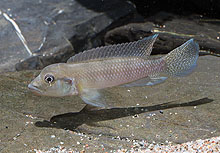WHAT'S NEW ACROSS THE WORLD
Select date in side bar to go to a What's New of previous issues
| What's New
©by Laif DeMason
As of this writing, we have just witnessed the wrath of Hurricane Dorian. Fortunately most in Florida escaped the worst of this destructive storm. Fringe effects were mostly loss of power. If you expect a prolonged period of power loss within 24 hours, remember DON’T feed your fish. They’ll be fine for over a week with no food. People of the northern Bahamas were not so lucky. Lesson to be learned, if a category 3, 4, or 5 hurricane is three days away, GET OUT! Remember, your life and your family’s lives are more important than anything you own.
Here’s “what’s new” on the cichlid scene: |
Lake Tanganyika
Interests in many groups of Tanganyikan fishes have been on a decline. Perhaps more accurately, only certain varieties are still of interest within a group like Tropheus, while the other group members, not so much. Fortunately, hobbyists are looking elsewhere for the not-often-seen species to buy. Recently, many of the usual Burundi fishes are of interest now since the main exporter in Burundi closed down almost five years ago.
| WHAT'S NEW: LAKE TANGANYIKA |

One of the more recent imports of old is the Tanganicodus irsacsae from the Kigoma area of Tanzania. This fish is essentially the same fish as was exported by the hundreds for years from Burundi. The import size is usually less than 2.5 inches, but they will grow much larger in an aquarium. Photo by A. Konings.
|

Another recent import from the north is the Julidochromis from Katabe, Tanzania. Usually exported as J. marlieri, the coloration looks more like J. regani. In any event, these two fish are closely related and natural population coloration could depend on depth and substrate.
|

Many of the shell-dwelling lamprologines are still popular with specialty hobbyists. Recently we’ve seen a rarely-imported shell fish, Lamprologus speciosus, from the southern Congo coastline. Other species are often confused with this rarity and imported under the same name.
|

Collected from the southern Bulu Point/ Mahale National Park shoreline is Xenotilapia singularis. Found in the same areas as X. ochrogenys, X. singularis males sport a series of dark spots along their flanks, similar to the Ndole Bay form from Zambia. Photo by A. Konings.
|
Lake Malawi
Sometimes it seems like wild Malawi cichlid enthusiasts may be hard to please. A lot of the demand in the USA and elsewhere seems to be fishes that are either seasonal or not found in big numbers in the lake. Collections are thus lengthy and time consuming in Tanzania and Malawi. Items from Mozambique are also being shipped via Malawi.

Some of the cichlids from the Lethrinops group are of interest, especially the large and pointy-nose species. Here a male of Taeniolethrinops sp. ‘furcicauda ntekete’ from Liuli, Tanzania that fits the bill. This fish is sold as Taeniolethrinops ‘Ntekete’.
|

Ever searching for different, colorful utaka to tempt Malawi cichlid hobbyists, this Copadichromis sp. ‘kawanga’ from Makonde, Tanzania, was shipped recently. This “dwarf borleyi” form sports a white blaze similar to the Kirondo population, but which is lacking in other populations. Photo by A. Konings.
|

Also exported sporadically—likely based on seasonality—is Copadichromis sp. ‘virginalis gold’ reportedly (yet unknown) from Pombo Reef, Tanzania. It is usually collected from the Nkanda region. The male of this fish has a yellow forehead blaze and is often called “Yellow Blaze Virginalis”. Photo by A. Konings.
|

Still a very popular fish among hobbyists is the man-made Dragon Blood peacock. Since the strain is a combination of more than two species, there is considerable variation in the offspring, even after many generations. This individual has many pleasing red spots in its fins and elsewhere.
|

After a pause in regular imports from Kinshasa, Congo, due to lack of connecting flights, imports have begun again. Here a cichlid species first shipped about a decade ago, Orthochromis stormsi has now arrived recently. Photo by O. Lucanus.
|

Another cichlid import, often sent as another species, Lamprologus congoensis. Congo fishermen are able to collect a fair number of medium-sized juveniles on a seasonal basis. Photo by O. Lucanus.
|
Select date in side bar to go a What's New of previous issues |









